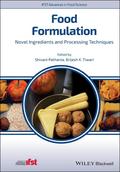Food Formulation
Novel Ingredients and Processing Techniques
IFST Advances in Food Science

1. Auflage April 2021
336 Seiten, Hardcover
Wiley & Sons Ltd
Reviews innovative processing techniques and recent developments in food formulation, identification, and utilization of functional ingredients
Food Formulation: Novel Ingredients and Processing Techniques is a comprehensive and up-to-date account of novel food ingredients and new processing techniques used in advanced commercial food formulations. This unique volume will help students and industry professionals alike in understanding the current trends, emerging technologies, and their impact on the food formulation techniques. Contributions from leading academic and industrial experts provide readers with informed and relevant insights on using the latest technologies and production processes for new product development and reformulations.
The text first describes the basis of a food formulation, including smart protein and starch ingredients, healthy ingredients such as salt and sugar replacers, and interactions within the food components. Emphasizing operational principles, the book reviews state-of-the-art 3D printing technology, encapsulation and a range of emerging technologies including high pressure, pulsed electric field, ultrasound and supercritical fluid extraction. The final chapters discuss recent developments and trends in food formulation, from foods that target allergies and intolerance, to prebiotic and probiotic food formulation designed to improve gut health. A much-needed reference on novel sourcing of food ingredients, processing technologies, and application, this book:
* Explores new food ingredients as well as impact of processing on ingredient interactions Describes new techniques that improve the flavor and acceptability of functional food ingredients
* Reviews mathematical tools used for recipe formulation, process control and consumer studies
* Includes regulations and legislations around tailor-made food products
Food Formulation: Novel Ingredients and Processing Techniques is an invaluable resource for students, educators, researchers, food technologists, and professionals, engineers and scientists across the food industry.
Chapter 1: Introduction to food formulation
Editors
1.1. Introduction
1.2. History
1.3. Economic releavance
1.4. Commercial applications
1.5. Book objective
1.6. Book structure
1.7. Conclusion
Chapter 2: Smart functional ingredients
Dr Milica Pojiæ
2.2. Introduction
2.3. Plants and animal sourced smart protein ingredients
2.4. Plant and animal sourced smart starch ingredients
2.5. Potential novel sources of food ingredients
2.6. Conclusion
Chapter 3: Healthy ingredients
Edward O'Neill
3.1. Introduction
3.2. Need for healthy ingredients
3.3. Salt replacers
3.4. Sugar replacers
3.5. Phosphate replacers
3.6. Bio actives
3.7. Peptides
3.8. Interactions with food components
3.9. Conclusions and future trends
Chapter 4: Ingredient interactions I
Dr. Savita Sharma
4.1. Introduction
4.2. Physical and chemical properties of macromolecules
4.3. Protein-carbohydrate interaction
4.4. Protein-
4.5. Conclusion
Chapter 5: Ingredient interaction II
Dr. Fabio Favati
5.1. Introduction
5.2. Effect of particle size distribution on food formulation
5.3. Effect of microstructure on food formulation
5.4. Effect of formulation on functional properties:
5.4.1. Emulsification behaviour
5.4.2. Texture attributes
5.4.3. Water absorption behaviour
5.4.4. Flavor
5.5. Conclusion
Chapter 6: 3D printing
Dr. Basharat Nabi Dar
6.1. Introduction
6.2. Principle
6.3. Application of 3D printing
6.4. 3D printed food products
6.5. Scalability
6.6. Conclusions and future outlook
Chapter 7: Encapsulation technologies
Dr Laura Trujillo
7.1. Introduction
7.2. Conventional techniques
7.3. Novel techniques
7.4. Combination techniques
7.5. Challenges associated with Encapsulation
7.6. Conclusion and future perspectives
Chapter 8: Advances in extrusion technologies
Prof. Charles Brennan
8.1. Introduction
8.2. Conventional process
8.3. Recent advances in extrusion process
8.4. Effect of processing conditions on food formulation
8.5. Conclusions
Chapter 9: Advances in thermal processing technologies/Green processing techniques
Dr. Ingrid Aguilo-Aguayo
9.1. Introduction
9.2. Conventional techniques
9.3. Emerging technologies in food formulation
9.3.1. Pulsed electric field
9.3.2. Ohmic heating
9.3.3. Microwave heating
9.3.4. Dielectric heating
9.4. Conclusions and future outlook
Chapter 10: Advances in non-thermal processing technologies
Dr. Maneesha Mohan
10.1. Introduction
10.2. Conventional techniques
10.3. Application of novel technologies
10.3.1. Ultrasonics
10.3.2. Novel freezing methods
10.3.3. Membrane technologies
10.4. Conclusions and Future outlook
10.5. Challenges and future recommendations
SECTION III: APPLICATIONS
Chapter 11: Tailor made functional food formulations
Dr. Carla.Brites
11.1. Introduction
11.2. Food formulation for high performing athletes
11.3. Food formulation for babies
11.4. Food formulations for pregnant/lactating mothers
11.5. Food formulations for ageing populace
11.6. Conclusion and future trends
Chapter 12: Formulations for food intolerances
Dr. Eimear Gallagher
12.1. Introduction
12.2. Celiac disease
12.3. Nutritional quality of celiac foods
12.4. Gluten free food products
12.5. Functional ingredients in gluten free products
12.6. Lactose intolerance
12.7. Lactose free formulations
12.8. Conclusion
Chapter 13: Prebiotic and probiotic food formulations
Tiina M. Mattila-Sandholm
13.1. Introduction
13.2. Need for probiotics and prebiotics
13.3. Probiotic food formulations
13.4. Prebiotic food formulations
13.5. Functional properties
13.6. Health effects
13.7. Conclusion
Chapter 14: Mathematical tools for food formulations
Dr Izabela Michalak
Prof. Colm o'Donnell
14.1. Introduction
14.2. Need for mathematical tools
14.3. Recent development in mathematical tools
14.4. Mathematical Models
14.5. Potential commercial applications
14.6. Conclusion and future trends
Chapter 15: Regulations and legislations
Jessica Vapnek
15.1. Introduction
15.2. Legislations on tailor made food formulations
15.3. Regulations on novel food ingredients
15.4. Regulations on use of novel technologies
15.5. Conclusion
Brijesh Tiwari is a Principal Research Officer at Teagasc Food Research Centre, Ashtown. His research interests include advanced food processing and extraction technologies. He is the series editor of the IFST Advances in Food Science book series. He currently serves as the Editor-in-Chief of the Journal of Food Processing and Preservation.


